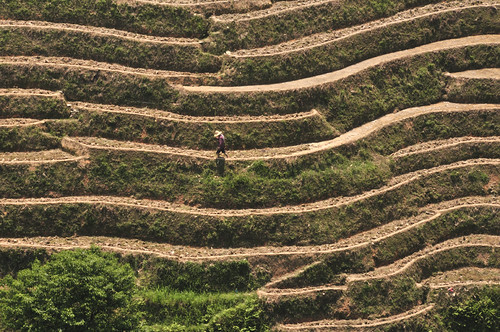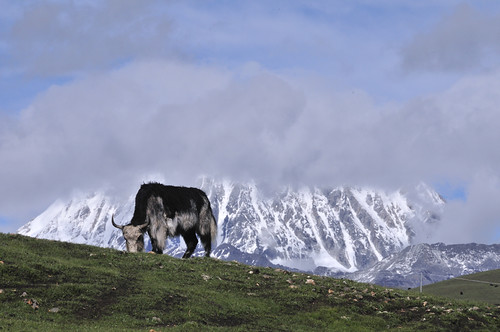23rd-24th May- Yangshuo to Longshen Rice Terraces
The journey to Longsheng got off to a late start, rising at 9.30
instead of 6.30 put us a few hours behind. But it wasn't long before
we were on our way and the morning sun greeted us through the glorious
rich blue atmosphere above us- the odd few White fluffy clouds and
stratus striations so uncommon in Yangshuo in Spring stayed with us
for the remainder of our 2-day excursion.
The journey is quite painless. 15Y to Guilin- 1.5Hr- Regular. 27Y to
Longshen- 2Hr. And finally hop on a bus to either Ping'an or Dazhai.
We opted for the latter as its smaller and far less setup for tourism.
The landscape undergoes a marked change as you approach Longshen. The
sharp rugged karsts give way to rolling hills with lush green bamboo
forrests and plantations covering the sides. Our road cuts through the
landscape with the only other variation being the terraced hill sides
which appear at irregular intervals. A hint of what I am expecting to
view in abundance further up the road.
Dazhai doesn't dissapoint and having wondered up the paths through the
heart of the terraces we find a spot for lunch overlooking vast
surrounding valleys, dotted with farmers diligently tending their
terraces. Dazhai is empty, but it seems setup in anticipation of the
volume of tourists we later encounter at Ping'an, but the fact is when
we passed through we were the only western people in sight.

The terraced valleys are awe inspiring. Its hard to comprehend the man-
power involved in building and maintaining the land. From the Dazhai
side of the rice terraces there are 3 viewing areas. You can walk to
each from the main village in 1.5hrs and between them in less.
Accomodation options are plentiful. That evening we took a bed in
Tiantou village, perched high up in the terraces overlooking Dazhai.
Rooms could be cheaper, we paid 60¥ for a double with bathroom.
The following day we made an early start and walked 30-mins up hill to
watch the sunrise at viewing post 1. You cannot view the sun from it's
low point on the horizon due to surrounding hills. None-the-less the
crisp morning light and orange glow on the hill side to the east is
worth it. The reflections in the terrace water are magical!

We then spent a leisurely morning on our guesthouse terrace reading. I
finshed Philip Pullmans, 'His Dark Materials' trilogy. Which I must
highly recommend to all, Lyra and Wills journey through the three
books is as epic as the scale of the terraces which surrounded me. The
hike from Dazhai to Ping'an is highly recommend. With an early start
you can complete the journey at a comfortable pace with plenty of time
to try to absorb the scale of the landscape, interact with the local
minority people and explore the intricate alleys in the numerous small
villages you pass along the way.
After around 4-5hours you arrive at the upper crest of the valley
surrounding Ping'an. From here there are a further 3-viewing stations.
Buy an ice cream and sit high on the valleyside watching the farmers
work the land before descending down the steps into Ping'an. Here you
have he option to stay in one of the countless guesthouses or catch a
bus back to Longshen. Buses are not very regular so we waited a little
over an hour with a few beers and discussed the days events.

















































